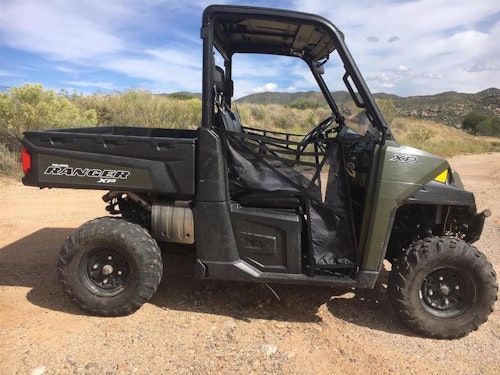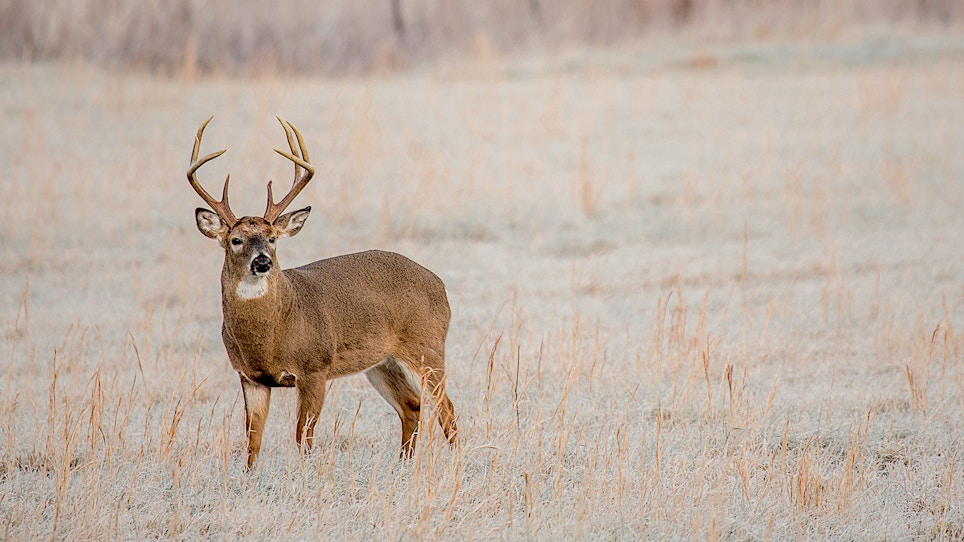We’d just turned into the woods off the CRP field, only 40 yards from the tree stand, when a huge 10-point buck bolted through the four-wheeler's headlight beams and disappeared into the darkness. I quickly turned to the bowhunter in my passenger seat and motioned for him to remain silent as we closed the distance to the stand.
As I eased to a stop at the base of the tree holding the hang-on stand, I picked up the eye shine of another deer 30 yards out in the pre-dawn darkness. When I flicked the headlights to high beam, we both could see a doe standing motionless and un-spooked evidently mesmerized by the light and familiar engine sounds.
With the doe blinded by the headlights, my client eased off the back of the four-wheeler and climbed slowly and quietly into the stand. I kept revving the motor and flicked the lights from high to low beam to keep the does attention centered on the machine. Once the bowhunter was situated, I slowly backed the four-wheeler up a few yards, turned around and drove right back out.
The client told me later that he figured when we spooked the buck on the way in that was the last he’d see of him. However, when it was light enough to see, the doe was still feeding nonchalantly. This surprised him. He was even more surprised a few minutes later. After making a couple soft, subtle doe grunts, the buck came back on the run to within easy bow range. He wasn't the least bit leery after having been run-off from the approaching four-wheeler. Less than a half hour after I had dropped the hunter off, he had a 150-class buck on the ground and a much fuller appreciation for why I don’t let clients walk to their stand, if I can avoid it.

Drive to Your Treestands
I learned a long time back that no matter how sneaky, quiet, seemingly scent free and careful a hunter is when going to their hunting stand, their incursions give deer a chance to pattern them. Eventually, deer will begin to avoid overhunted stand locations. This is especially true with mature bucks late in the season.
By driving hunters to the stand, there is little chance of deer scenting them.
Use Engine Noise and Headlights as Cover
What little noise or disturbance a hunter creates by getting situated is covered by the noise of the vehicle’s engine. We purposely keep the engines running so the noise diverts the attention of nearby deer. In the pre-dawn darkness, we also leave the headlights on, shining away from the stand. This also grabs deer’s attention, and mask the hunter’s movements. We do not leave until the hunter signals he is situated.
Follow the Same Driving Patterns
When we drive on our properties prior to and throughout the season, we follow the same exact pattern and routes. We want the deer to become accustomed to our vehicles and travel routes. When we take a hunter to the stand, we follow our normal route and will often drive past the chosen stand, continuing through the area to alert any deer to our innocuous presence. This gives them a chance to move off without the threat of danger. We then circle back and drop the client off without having to worry about a deer standing back in the woods watching the hunter get situated.
This tactic can present problems for hunters on their own. Getting someone to drive you to the blind or stand may not always be possible. Still, I would rather drive through the area in a vehicle of some sort and let it spook the deer prior to going to the stand. Park it as unobtrusively as possible nearby and move cautiously to your ambush location.
Remain In the Stand, Even After Making a Shot
We do not allow our clients to leave the stand or blind for any reason once we get them situated. We provide urine bottles or containers to use in the stand or blind. If they shoot a deer, they immediately contact us via text or radios provided. After making the call, the hunter stays put until we arrive at the blind or stand.
It’s difficult for a hunter to remain in the stand when he has just shot (or shot at) a deer. Adrenalin is high, especially if a hunter can see the downed deer. Yet, as outfitters, we don’t just hunt a few days and stop. We hunt from archery season through late season, about two months, non-stop. We try our hardest to create sanctuaries on our leases that actually attract pressured deer from neighboring properties. So by simply going to check a downed trophy, a hunter could spook nearby deer, negating our efforts.

Tips for Deer Recovery
We recover the downed deer with minimal activity and conversation. We never gut a deer on the lease where it was killed, especially around our food plots. The last thing we want to do is attract coyotes or other scavenging predators to the area.
Wait Overnight to Track a Wounded Deer
When we arrive on the scene and the hunter cannot pinpoint the downed deer, we investigate thoroughly. We want to know where the deer was hit (location on the body), the deer’s reaction and where the deer was last seen before making the first move to search.
If a client isn’t sure of his shot, we carefully search the area for a blood trail, trying to determine where the animal was hit. If we cannot ascertain where the deer was hit or we lose the blood trail within approximately 100 yards, we leave the area. If we suspect a “gut” hit or if it’s after dark, we leave the area. Tracking a wounded deer at night is a good way to lose it for good, and a sure way to lose a gut-shot deer. A wounded deer, especially a gut-shot deer, will generally bed down within a couple hundred yards of where it was shot. If not spooked, the deer will likely stay put or re-bed a number of times within a small area. If noisy, vocalizing, flashlight-toting searchers alert the wounded deer, it will likely sneak out of the area. It may even travel a long distance, leaving scant or no blood trail, before bedding again.
Over many years of observing and dealing with wounded and gut-shot animals, I’ve learned to back off and wait at least 18-24 hours before trying to recover them. Waiting provides no guarantees, however. On numerous occasions, when we recovered a wounded animal, it had taken its last breath within minutes of us finding it. Had we disturbed it six, eight or even twelve hours after it was hit, in all likelihood, we would not have recovered it. Recovering a wounded animal, deer included, hinges on patience.
Scavenger birds such as crows, ravens, magpies, buzzards or even eagles can often help you pinpoint a downed deer. Keep your ears open for coyote sounds, which can be another indicator of a dead critter in the vicinity. I hate leaving a wounded deer overnight where there is a good chance coyotes will find and ravage the carcass. However, finding and recovering any part of a hit deer is better than losing it.
Hunting Food Plots Sparingly
Food plots contribute to our high hunter success rate. We spend both time and money to make our food plots work for us. Food plots are planted away from roads, neighboring property boundaries and in locations where we can glass them from a distance to pattern deer use. We also do some serious predator control in and around the food plots to minimize their impact on the deer herd. In a given year, we may only hunt a key food plot three or four times. But we harvest trophy buck more times than not on our food plots.
Taking Advantage of Prevailing Winds
Each and every one of our stands and blinds are placed to take full advantage of the various wind conditions. Many of our stand and blind locations have been utilized for years. Still, we constantly monitor the weather and operate by the judicious use of our powder bottles to keep apprised of the current and upcoming wind conditions. We simply do not hunt locations where the prevailing breeze is not suitable.
Being an outfitter with years of guiding experience catering to trophy, whitetail-seeking clients has provided me the opportunity to make more mistakes in one year than a do-it-yourself deer hunter gets over many years. These mistakes provided learning opportunities and knowledge gained. I use this knowledge to hunt smart, overcoming as many of the trophy whitetail’s strengths as possible. I hope you can too.
Judd Cooney runs Iowa Trophy Whitetail Outfitters, a quality trophy whitetail and turkey operation in the hill country of western Iowa where the bucks are humongous.
Featured photo: iStock/Roger Trentham






